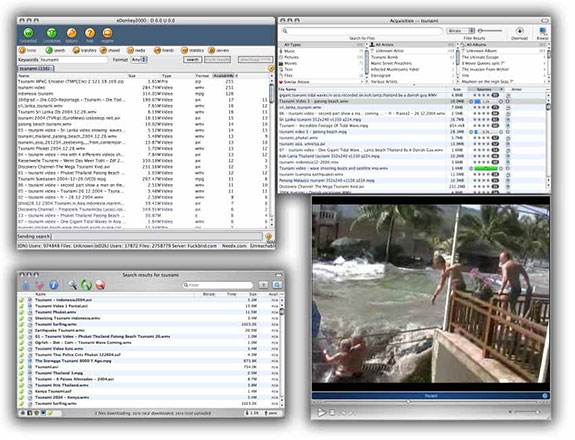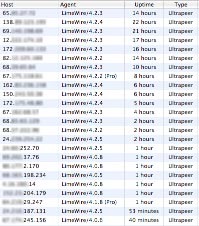BitDepth 456 - January 18
11/01/09 17:42 Filed in: BitDepth - January 2005
Peer to peer networks shine as a distribution channel for videos of a disaster.
The relentless flow of files

Video files on three different server networks, from bottom left, are FastTrack/Kazaa, eDonkey, Limewire/Gnutella. The video still is taken from an uncredited file titled "Tsunami Video 2.wmv" parts of which have aired on international television. Images by Mark Lyndersay.
The ethics of the way peer to peer networks (P2P) are used has always proved to make for messy debates. The technologies usually act as enablers, allowing people around the world to offer files for others to download in a kind of parallel universe of freeness on the Internet.
Far from the public worlds of sanctioned download sites like Tucows and VersionTracker, the P2P networks are the shadowy alleyways of the Internet, where files of doubtful lineage are passed between furtive hands.
The first P2P network to come to widespread public attention was Shawn Fanning's Napster, on which a business was shakily built. Napster's key feature, the indexes the master servers kept of available files that made downloading files so seamless, became the breadcrumb trails that an outraged recording industry followed to successfully point a finger of blame at the company for a massive upsurge in illegal trading of MP3 files of licensed music.
Nothing has appeared since that works quite as well as Napster did because nothing else uses those kind of indexes. Even Kazaa, the most popular tool for trading files since Napster has become problematic, dropping unwanted advertising and spyware on PCs like a diarrhetic flock of seagulls.
I trawl the popular Gnutella network a collection of linked, Limewire-based servers around the world to see what's popular. The Gnutella network is often agonisingly slow to use, and downloads are so readily aborted that it's often pointless trying to grab even small files, so I scroll around to see what's popular.
It's a kind of eerie, if fundamentally populist barometer of the zeitgeist, the only place where Britney Spears rubs shoulders with Bing Crosby and Snoop Dogg. It was here that I noticed a surprising rise in popular trading in files on a surprising subject, videos of the Indian Ocean Tsunami.
What first seemed like a trickle eventually became a deluge of data as I kept hitting the reload button. There were dozens of these files being offered by hundreds of people. Some of the clips were taken from Asian television, others seemed to be unusually long takes straight from the video cameras, chillingly intimate views of a terror sanitized by broadcast editing.
In one sequence, a videographer captured a long shot from the second story of a hotel, the surging waters snatching two tourists struggling to reach the balcony with imperious force. As the long, disturbingly uncut video continues, the camera lurches crazily up and down and it finally becomes clear that the waters have risen to waist height on the second floor and the videographer is balancing precariously on top of a floating table.
You won't find any Perfect Storm moments here. There are no dramatic moments when you can see the scope of the disaster clearly. The huge wave comes crashing inland in video clip after clip, and it just keeps coming, the water rising and surging inexorably. This dirty, swirling water behaves unlike anything we've seen in movies, crashing through walls, wrapping around trees, sucking and pulling at anything in its path.
Beyond the shocking, sometimes graphic images on some of these videos is the realisation that in a matter of days, video shot by amateurs had been made available to the world using these networks by amateurs. P2P filesharing of news footage isn't broadcasting, but it's something new, an unfiltered view of a disaster as it happens without the intervention of the normal gatekeepers of information.
It could just be disaster porn, or it could be technology maturing out of petty theft into information databasing, difficult images of the news that found another way to be seen.
 About Peer to Peer Networks.
About Peer to Peer Networks.
As you linger on a Gnutella/Limewire network, servers are found and their files are offered to your searches.
For anyone who's worked on a networked computer (and every computer on the Internet is one by definition), the principle seems straightforward. Establish a connection to the other system, find the file you're looking for and copy or download it. That's the way FTP, the most common file transfer protocol on the Internet works.
Modern P2P networks use a technique known as swarming. When you connect to a popular file on the Limewire/Gnutella network, the file may come from one computer or it may come from many. The software is smart enough to reassemble your download even if it comes from ten different computer systems.
BitTorrent, the popular swarming download client that's become indispensable to movie pirates, takes the technique to its apotheosis.
There are no files on the BitTorrent network, only tiny pointers known as torrents. When you load one of these into the client, it does two things, first it finds any computers that are offering the torrent for download, then it offers the file you're downloading to anyone else who is looking for it.
It's possible to be sending a file out faster to other BitTorrent users than you're getting it and during most of a fairly large download, only a few BitTorrent users will have the whole file while this is going on, just partially transmitted data that's in an unusable state. Torrents are co-operative computing by design.

Video files on three different server networks, from bottom left, are FastTrack/Kazaa, eDonkey, Limewire/Gnutella. The video still is taken from an uncredited file titled "Tsunami Video 2.wmv" parts of which have aired on international television. Images by Mark Lyndersay.
The ethics of the way peer to peer networks (P2P) are used has always proved to make for messy debates. The technologies usually act as enablers, allowing people around the world to offer files for others to download in a kind of parallel universe of freeness on the Internet.
Far from the public worlds of sanctioned download sites like Tucows and VersionTracker, the P2P networks are the shadowy alleyways of the Internet, where files of doubtful lineage are passed between furtive hands.
The first P2P network to come to widespread public attention was Shawn Fanning's Napster, on which a business was shakily built. Napster's key feature, the indexes the master servers kept of available files that made downloading files so seamless, became the breadcrumb trails that an outraged recording industry followed to successfully point a finger of blame at the company for a massive upsurge in illegal trading of MP3 files of licensed music.
Nothing has appeared since that works quite as well as Napster did because nothing else uses those kind of indexes. Even Kazaa, the most popular tool for trading files since Napster has become problematic, dropping unwanted advertising and spyware on PCs like a diarrhetic flock of seagulls.
I trawl the popular Gnutella network a collection of linked, Limewire-based servers around the world to see what's popular. The Gnutella network is often agonisingly slow to use, and downloads are so readily aborted that it's often pointless trying to grab even small files, so I scroll around to see what's popular.
It's a kind of eerie, if fundamentally populist barometer of the zeitgeist, the only place where Britney Spears rubs shoulders with Bing Crosby and Snoop Dogg. It was here that I noticed a surprising rise in popular trading in files on a surprising subject, videos of the Indian Ocean Tsunami.
What first seemed like a trickle eventually became a deluge of data as I kept hitting the reload button. There were dozens of these files being offered by hundreds of people. Some of the clips were taken from Asian television, others seemed to be unusually long takes straight from the video cameras, chillingly intimate views of a terror sanitized by broadcast editing.
In one sequence, a videographer captured a long shot from the second story of a hotel, the surging waters snatching two tourists struggling to reach the balcony with imperious force. As the long, disturbingly uncut video continues, the camera lurches crazily up and down and it finally becomes clear that the waters have risen to waist height on the second floor and the videographer is balancing precariously on top of a floating table.
You won't find any Perfect Storm moments here. There are no dramatic moments when you can see the scope of the disaster clearly. The huge wave comes crashing inland in video clip after clip, and it just keeps coming, the water rising and surging inexorably. This dirty, swirling water behaves unlike anything we've seen in movies, crashing through walls, wrapping around trees, sucking and pulling at anything in its path.
Beyond the shocking, sometimes graphic images on some of these videos is the realisation that in a matter of days, video shot by amateurs had been made available to the world using these networks by amateurs. P2P filesharing of news footage isn't broadcasting, but it's something new, an unfiltered view of a disaster as it happens without the intervention of the normal gatekeepers of information.
It could just be disaster porn, or it could be technology maturing out of petty theft into information databasing, difficult images of the news that found another way to be seen.

As you linger on a Gnutella/Limewire network, servers are found and their files are offered to your searches.
For anyone who's worked on a networked computer (and every computer on the Internet is one by definition), the principle seems straightforward. Establish a connection to the other system, find the file you're looking for and copy or download it. That's the way FTP, the most common file transfer protocol on the Internet works.
Modern P2P networks use a technique known as swarming. When you connect to a popular file on the Limewire/Gnutella network, the file may come from one computer or it may come from many. The software is smart enough to reassemble your download even if it comes from ten different computer systems.
BitTorrent, the popular swarming download client that's become indispensable to movie pirates, takes the technique to its apotheosis.
There are no files on the BitTorrent network, only tiny pointers known as torrents. When you load one of these into the client, it does two things, first it finds any computers that are offering the torrent for download, then it offers the file you're downloading to anyone else who is looking for it.
It's possible to be sending a file out faster to other BitTorrent users than you're getting it and during most of a fairly large download, only a few BitTorrent users will have the whole file while this is going on, just partially transmitted data that's in an unusable state. Torrents are co-operative computing by design.
blog comments powered by Disqus

